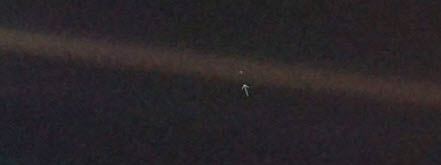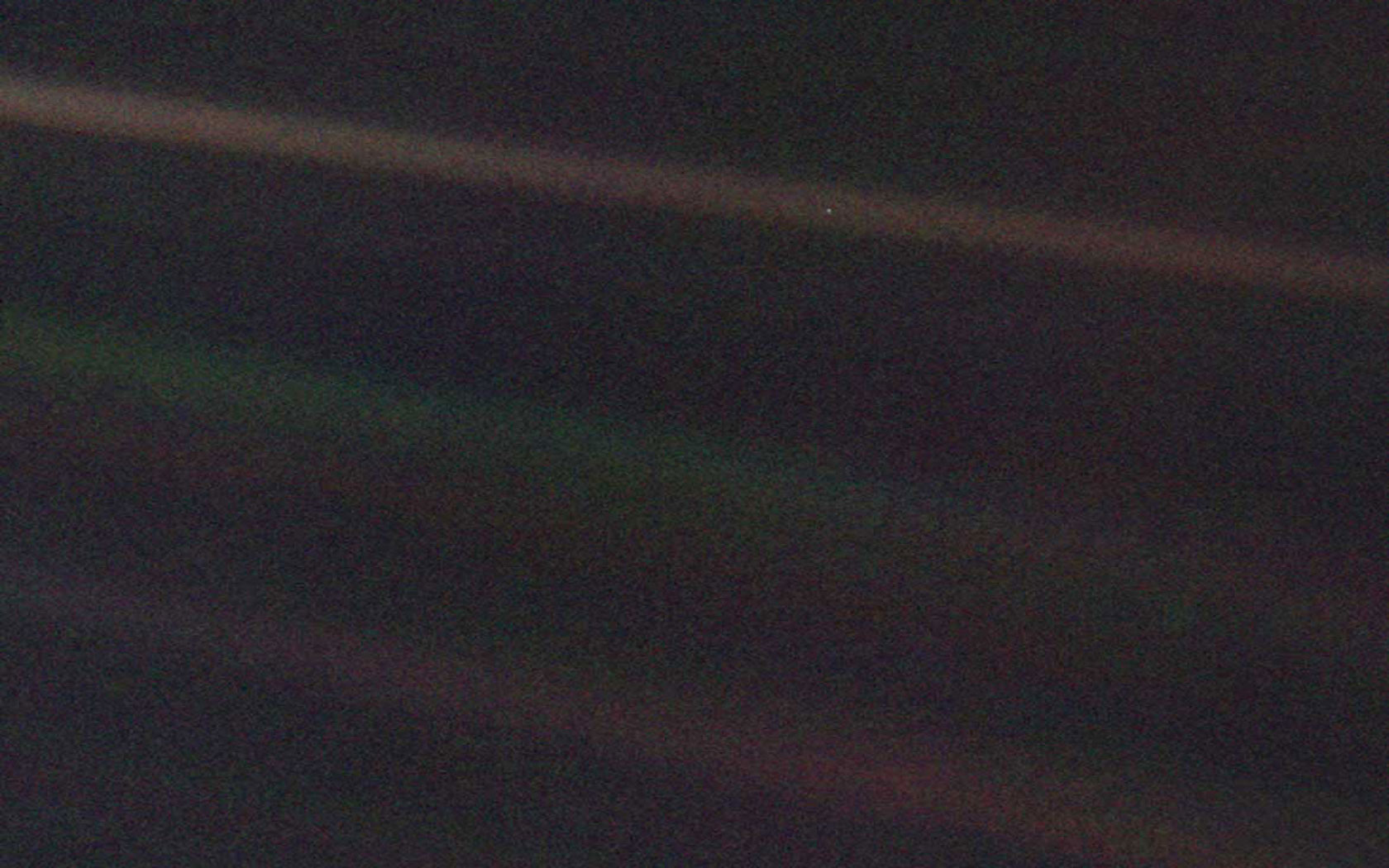File:Pale Blue Dot.jpg: Difference between revisions
Siterunner (talk | contribs) No edit summary |
Siterunner (talk | contribs) No edit summary |
||
| Line 28: | Line 28: | ||
The photograph was captured by Voyager 1, a spacecraft launched in 1977 with the initial purpose of studying the outer Solar System. After fulfilling its primary mission and as it ventured out of the Solar System, the decision to turn its camera around and capture one last image of Earth emerged, in part due to Sagan's proposition. | The photograph was captured by Voyager 1, a spacecraft launched in 1977 with the initial purpose of studying the outer Solar System. After fulfilling its primary mission and as it ventured out of the Solar System, the decision to turn its camera around and capture one last image of Earth emerged, in part due to Sagan's proposition. | ||
| Line 40: | Line 38: | ||
Voyager 1 was expected to work only through the Saturn encounter. When the spacecraft passed the planet in 1980, Sagan proposed the idea of the space probe taking one last picture of Earth. He acknowledged that such a picture would not have had much scientific value, as the Earth would appear too small for Voyager's cameras to make out any detail, but it would be meaningful as a perspective on humanity's place in the universe... | Voyager 1 was expected to work only through the Saturn encounter. When the spacecraft passed the planet in 1980, Sagan proposed the idea of the space probe taking one last picture of Earth. He acknowledged that such a picture would not have had much scientific value, as the Earth would appear too small for Voyager's cameras to make out any detail, but it would be meaningful as a perspective on humanity's place in the universe... | ||
Over the years, the photograph has been revisited and celebrated on multiple occasions, with NASA acknowledging its anniversaries and presenting updated versions, enhancing its clarity and detail. | |||
Revision as of 08:25, 20 June 2024
Seen from about 6 billion kilometers (3.7 billion miles), Earth appears as a tiny dot within deep space: the blueish-white speck almost halfway up the rightmost band of light.
Pale Blue Dot
- Artist: Voyager 1
- Year: 1990
- Type: Astrophotography
- Location: Interstellar space
- Owner: NASA
Pale Blue Dot is a photograph of Earth taken on February 14, 1990, by the Voyager 1 space probe from an unprecedented distance of approximately 6 billion kilometers (3.7 billion miles, 40.5 AU), as part of that day's Family Portrait series of images of the Solar System.
In the photograph, Earth's apparent size is less than a pixel; the planet appears as a tiny dot against the vastness of space, among bands of sunlight reflected by the camera.[1] Commissioned by NASA and resulting from the advocacy of astronomer and author Carl Sagan, the photograph was interpreted in Sagan's 1994 book, Pale Blue Dot, as representing humanity's minuscule and ephemeral place amidst the cosmos.
The photograph was captured by Voyager 1, a spacecraft launched in 1977 with the initial purpose of studying the outer Solar System. After fulfilling its primary mission and as it ventured out of the Solar System, the decision to turn its camera around and capture one last image of Earth emerged, in part due to Sagan's proposition.
Background
In September 1977, NASA launched Voyager 1, a 722-kilogram (1,592 lb) robotic spacecraft on a mission to study the outer Solar System and eventually interstellar space. After the encounter with the Jovian system in 1979 and the Saturnian system in 1980, the primary mission was declared complete in November of the same year. Voyager 1 was the first space probe to provide detailed images of the two largest planets and their major moons.
The spacecraft, still travelling at 64,000 km/h (40,000 mph), is the most distant human-made object from Earth and the first one to leave the Solar System. Its mission has been extended and continues to this day, with the aim of investigating the boundaries of the Solar System, including the Kuiper belt, the heliosphere and interstellar space. Since its launch, it receives routine commands and transmits data back to the Deep Space Network.
Voyager 1 was expected to work only through the Saturn encounter. When the spacecraft passed the planet in 1980, Sagan proposed the idea of the space probe taking one last picture of Earth. He acknowledged that such a picture would not have had much scientific value, as the Earth would appear too small for Voyager's cameras to make out any detail, but it would be meaningful as a perspective on humanity's place in the universe...
Over the years, the photograph has been revisited and celebrated on multiple occasions, with NASA acknowledging its anniversaries and presenting updated versions, enhancing its clarity and detail.
○
File history
Click on a date/time to view the file as it appeared at that time.
| Date/Time | Thumbnail | Dimensions | User | Comment | |
|---|---|---|---|---|---|
| current | 15:11, 6 May 2014 |  | 399 × 198 (21 KB) | Siterunner (talk | contribs) | Category:Green Graphics |
You cannot overwrite this file.
File usage
The following 5 pages use this file:

